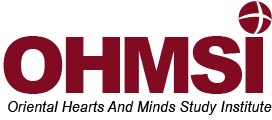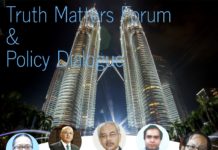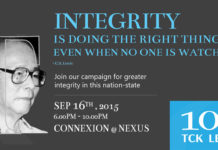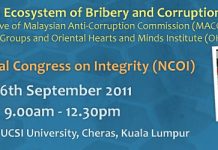
Draft Memorandum for Review
6th National Congress on Integrity (NCOI)
16th September 2011, UCSI University
Against Bribery and Corruption for all Malaysians (ABC4Malaysians)
Corruption is often seen as too big and too complicated of an issue to be easily discussed and dissected, especially within the context of a forum or meeting with limited time, resources and expertise. This does not mean that interested citizens and groups who want to play their part in tackling this issue within the context of Malaysia should not try to find common ground in understanding this issue and then devise ways for people to come together to combat the scourge of corruption in this country.
It was with this intention in mind that a group of interested individuals gathered together on the 28th of July at the Malaysian Anti-Corruption Academy (MACA) as part of a preparatory meeting for the 6th National Congress on Integrity. The following report documents and highlights key points arising from this meeting.
This report uses the DEEP methodology of Describing the Problem, Explaining the Causes, Evaluating the persistence of the problem and finally, Prescribing a way forward, in order to frame the content of the discussion on the 28th of July.[1] In doing so, a more systematic and structured way of understanding the problem or issue at hand can be obtained and the most suitable channels for moving forward this agenda forward can be more easily identified.
I. Describing the Problem
The approach taken by the professional process consultant and moderator was to contextualize examples of corruption within personal experiences (or that of their family and friends) and then to expand or extrapolate the thinking of participants to cover bigger and broader issues. The discussion was then generalized to other current examples of corruption within the larger context of Malaysia’s socio-political system. The personalization of corruption allowed the participants to see how these experiences affected one’s own feelings towards this issue and how it would shape an individual’s future views on the matter. Through the contextualization of real life examples of corruption, various aspects of the problem, including definitional and theoretical issues, were also drawn out in the process.
Most of the personal experiences with corruption described by the participants involved dealings with various personnel at the lower echelons in the civil service (which includes the police). The example of being stopped by a member of the police force for a traffic infraction (whether real or not) and being asked to pay a bribe to be ‘let off’ was a common experienced described by many of the participants. Most identified with this reality. It can be concluded to be a Malaysian way of life.
For example, Malaysian A related his personal experience about jumping the red light and how the police had stopped him and attempted to get a bribe from him. When A did not want to, the police kept pleading to give him something. His reflection of the experience was initially relief, then pity. This experience from his early formative years has colored his opinion of how he views corruption. Every time he returns to the location where it occurred, which was near Komtar in Penang, he can feel his heart beating faster.
Problem Description I: Corruption occurs when a party which has the power to enforce law demands for a bribe or payment so that the law is not enforced. This is popularly known as “the close-one eye culture or the duit kopi culture.”
Another type of corruption was demonstrated through the experience shared by Malaysian B.
B’s friend had been caught for a violation with a motorbike, and asked for his help. He argued that the rules can be bent but cannot be broken. Corruption can be endemic but there are creative ways to deal with it. His friend, a Traffic Police Officer, had obviously figured it out – that you can bend the rules without breaking them; such is the case of “organisational grace”, wherein the system allows you to ‘legally admit fault and seek a lower fine.’
Even here, while it is not so much that a bribe was demanded but that a request was made for power to be abused so that the proper legal action would not be taken. In this case, the ‘price’ was the friendship between B and his friend. In other cases, such an abuse of power could easily have been accompanied by a bribe (or favours) to a high ranking official so that he or she would not follow through on the proper and legally specific punishment, sometimes even where such legitimate provisions for leniency is not provided.
Problem Description 2: Corruption occurs when a higher authority is asked (because of friendship, familial ties, personal favours, bribes, etc…) to exercise power, often over ruling another lower authority, so that the proper legal procedures (including punishments) can be circumvented.
Bribes are not necessarily extracted during the time when a favor is needed or when there is the need for normal procedures to be circumvented. Bribes could also be paid ‘in advance’ with the expectation that these are ‘down payments’ for yet to be specified favors to be expected in the future. Also, bribes may be paid after the fact (when the favor has already been done).
For example, Malaysian C described the experience of her father, who was a District Officer in Johor Bahru who would, as usual, during festive seasons, receive many goodwill hampers.
Problem Description 3: Corruption can also occur when gifts are given in advance of when a favor needs to be extracted with the expectation that these gifts or bribes can be ‘cashed in’ in the future or when gifts are given away after the favor has been extracted as a ‘thank you’ for past favors rendered. Since these gifts are not given during the period when the favor is done, it can ‘absolve’ the giver and the receiver of any guilt that this is indeed a corrupt act.
Another personal experience related by Malaysian C highlights the aspect that bribes can be extracted as part of the natural cost of doing business or overcoming transaction costs, if you will.
C’s family opened a kiosk in Bukit Bintang and wanted it renovated. It cost only RM 20,000 but she claimed that she had to go to Dewan Bandaraya Kuala Lumpur as many as 19 times to get it approved. She related that the officers in DBKL said that she must use a runner; but after the 19th time, she met the minister and asked him why it is so difficult. Then the fasting month came, and she said she could no longer deal with DBKL and decided to close the kiosk. Soon after, the whole stretch of kiosks closed.
Problem Description 4: Corruption can occur when those in power put in additional procedural barriers in obtaining the necessary approval / paperwork as a means of extracting payment to ease these procedural steps. The addition of a ‘runner’ into the process provides a convenient layer so that there can be denial on the part of the approving authority that he or she asked for a bribe and also on the part of the person seeking the necessary approval, that the payment was just part of the cost of doing business
Systemic corruption unveiledThe issue of corruption at a more systemic level was highlighted in the discussion regarding a Malaysian Dr. D, a forensic pathologist who was shown to have falsified his autopsy report on a particular case, wherein a person of interest in a crime died whilst under police custody. Here, corruption occurred at a more serious institutional level when it seemed that Dr. D was compelled to falsify his report, presumably by higher up authorities, who wanted to (or was asked to) protect the public image of the police. Corruption may therefore also have occurred on the part of the Malaysian Medical Council (MMC) who let Dr D go “off the hook” with only a ‘severe reprimand’ over his actions.
A participant pointed out that there are two failures, in the case of Dr D and institutionalized “close one eye culture.” It appeared that pressure was brought down upon the system by higher ups, while the MMC also “colluded and failed” to punish Dr D in regards to the gravity of the crime in a commensurate manner. International Medical guidelines had an established standard punishment for such crimes but which was obviously ignored.
The first failure can be seen as somewhat similar to Problem Description 2. A lower level officer was asked to ‘close one eye’ and ignore a minor violation but with much more drastic consequences, in this particular case, the failure to uncover the identity of a possible murderer. The second failure points to the more serious problem of institutionalized corruption where various bodies or arms of the government (and related agencies / organizations) operate within a system where there is an undersanding that these different agencies would and could ‘cover for one another’. Jerry Harvey, in his book, The Abilene Paradox and Other Meditations on Management calls this “a system of willing voluntary collusion” in wrong doing but when often absolve the actors excuse themselves with the argument that they were only following orders.” Please read Hannah Arendt’s Eichmann in Jerusalem.
Problem Description 5: An endemic system of corruption begins to appear when there is an understanding between various agencies (especially within government or related parties) that the abuse of power can and should take place in order to protect the interests and reputation of the government or representative community as a whole.
In addition, another medical professional and participant pointed out that within the current structure of the MMC, which was composed of a large number of “administrative insiders,” such larger numbers appointed by the President of the Council does not encourage transparent open and a accountable system. Apparently, the disciplinary committee of the MMC is made up of 3 to 6 members but only two are actually needed for a quorum. All of these are appointed by the President of the Council. While not all medical professionals may agree with the participants diagnosis of the weakness of the MMC’s structure (including the disciplinary board), his views may describe the structural components of institutionalized corruption. The greater concern of the Consultation was that this mode of “institutionalized governance of professional bodies is becoming increasingly greater!” The latest model being debated is the Malaysian Press Council.
Problem Description 6: The structure of organizations can influence the level of transparency and decision making and hence the ability to hide (or reveal) corrupt practices within the organization.
There are many more examples of encounters with corruption at a personal level and cases of corruption at an institutional level which would highlight different aspects of the problem and hence, different descriptions of the problem.
For example, one could mention the often heard examples of how a ‘commission’ is demanded from the allocation of a government project to a private corporation or through the sale of state owned land to a private entity and so on. The point to note here, through the examples of corruption at the personal and institutional level, is that it reveals corruption in different places taking on different forms. This obviously complicates the challenge of ‘describing’ corruption in a simplistic manner.
The intricacies revealed by these descriptions will be discussed in further detail in Part III of this report which evaluates the problem of corruption in a more systematic and structured manner.
The participants, however, did not only point to negative examples of corruption to describe the problem. Some also pointed to counter examples of how corruption was avoided at the personal as well as institutional level.
For example, Malaysian C described her father’s rejection of all the hampers received during festive seasons because of their ‘haram’ nature. He did not want to feed his children with ‘haram’ money or gifts. Malaysian E shared his experience of how his father made him bike for 45 minutes because the father had forgotten to pay the hawker RM0.20. The father was a Chief Health Inspector and would similarly reject all gifts he received during festive seasons. For him, the true test of sincerity would be to see if he would be similarly appreciated after he retired and could no longer do any more ‘favors’ because of his position in the civil service.
While the returning of the 20 sen was not necessarily a case of avoiding corruption, the point made here was that one has to travel the extra mile in order to avoid being seen as corrupt. In addition, good examples set by parents are very effective in defining what corruption is and how to avoid corruption.
Problem Description 7: It is not sufficient to be uncorrupt but one has to take the extra step to avoid to be seen as possibly corrupt. Parents and elders have an important role here.
Problem Description 8: The corrupt acts of individuals will be seen by those closest to them and will negatively influence the younger generation and make them think that corruption is an acceptable practice. Conversely, examples of honest and principled living will go a long way in influencing the younger generation to shy away from corruption.
The cases and experiences described above sets the scene for the next two sections which is to explain some of the causes of corruption using these problem descriptions and subsequently evaluating the problem in a more systematic fashion.
In every one of the cases described above, those who are guilty of asking for bribes or those who abuse their positions of authority are not punished for their actions. For example, even though almost everyone knows that police enforcing speed traps are using these opportunities to ‘extract’ money from drivers, there are no enforcement mechanisms to catch the police ‘in the act’. This means that such actions will continue to take place. In the example described by Malaysian C, even the Minister did not offer her any solutions to the problem she was facing. Similarly, in the forensic pathologist case, he escaped with merely a slap on the wrist from the MMC. Obviously, all those in authority are also colluding with this close one-eye culture and simply tolerating it!
Cause 4: Inequality in information / power
Those in positions of authority usually have more information (or more power to apply that information selectively) compared to those who are not in authority. Those who are not in authority usually do not have formal channels of appeal if those in authority decide to abuse their power. For example, the officials in DBKL will insist that the legal provisions require C’s kiosks to have certain dimensions (even though this may not be the case) while C’s staff would have no way of disputing this or cannot access a higher ranking official in order to seek greater clarification on some of these terms and conditions. The greater the complexity of the procedures involved, the greater the inequality of information and power, and the greater the opportunity for the abuse of power and the extraction of bribes.
Cause 5: Once unequal structures are put in place, they are very difficult to remove
All organizational structures have their inherent weaknesses which can be potentially exploited. Which is why there is a need for be periodic reviews in these structures and regular rotation among those in power. But once these structures are in place, it empowers those in authority and those coming after them to benefit from these structures which means that the impetus to change these structures in order to remove or reduce institutionalized corruption is very difficult.
One can easily point to other causes of corruption which were not discussed in Section I including the needs of political parties and politicians for funds to run their political campaigns, the lack of institutional checks and balances within an organization, or in the larger government structure e.g. an Internal Investigations Department within the Police Department and the weakness of the agency in charge of anti-corruption prosecutions, the relatively low pay of civil servants and so on. The point to make here is that the descriptions of the problem highlighted in Section I can be linked to specific causes of corruption, a few of which has been highlighted in this section.
The more causes we reveal and then seek to understand, the greater the likelihood of identifying channels (including out-of-the-box ideas) of reducing or event eradicating the problem of corruption.
Fourthly and finally, one has to ask questions regarding the larger environment in which these acts of corruption are taking place e.g. what is the reputation of enforcement agencies, what is the role of the media in being whistleblowers etc.
Table 1 below summarizes the main points in this evaluation section.
Table 1: Asking the right questions to obtain a more structured and deeper understanding of the issue
|
Overarching Question
|
Points to consider
|
|
1) Who are the main actors?
|
Are there only two actors?
Who, along the hierarchy, needs to be ‘paid’ off?
Who are the parties who may be complicit without being paid off?
Are there any middlemen?
|
|
2) What is the nature of the transaction
|
What laws are being flouted?
Who is flouting them?
What holds the advantage in the balance of power to necessitate this kind of transaction?
What kinds of procedures need to be taken in order to this transaction to go through?
|
|
3) Costs / Benefits involved
|
How much money is being paid out?
If there is a middleman, how much is he or she getting?
How much does the payee / briber stand to ‘save’ or ‘benefit’ from this transaction?
What is the likelihood of being caught?
What reputational concerns are at stake?
What are the possible costs to society at large i.e. externalities?
|
|
4) What is the larger anti-corruption environment in which these actors are operating in?
|
How much power to the enforcement agencies have?
What active is the media in exposing these sorts of activities?
Are there strong whistleblower protections?
How effective are those within the opposition in playing the role of check and balance?
How active are the NGOs?
|
(Of course, there are additional questions which can be asked and alternative structures to frame the evaluation of the problem. Here, the point is to highlight the need for a structure that digs deeper into the root of the problem, that goes beyond a generic discussion of cases involving abuse of power and corruption)
The paper is designed as a real life case story of the actual experiences of some Malaysians and the dialogue was hosted by the MACC. The goal of this paper is to “em-courage Malaysians as ordinary citizens to get involved and have their say in the fight against corruption.
















